Portland Head’s Other Guiding Light
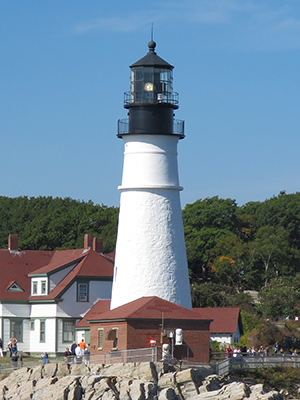
(Bob Trapani, Jr. photo)
For the first 182 years of Portland Head Light’s history, the beacon ablaze at the top of the venerable sentinel was the lone focal point for mariners seeking safe passage in and out of Portland Harbor.
During this time, Portland Head’s distinctive gleams were broad strokes of illumination upon a nightly canvas of darkness. However, the lifesaving powers of the beacon were limited to showing a general proximity of the harbor channel rather than indicating a safe alignment for vessels making their approach from sea.
This all changed in 1973 when the United States Coast Guard established an additional navigational aid – a directional light, at the historic light station. Chances are, due to its unique appearance and the fact that the unit’s small circular lens was visible seaward only, many visitors to Portland Head over the years may have easily missed this vital navigational aid.
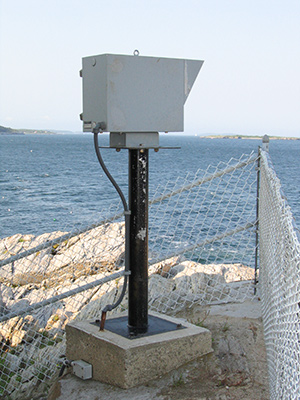
(Bob Trapani, Jr. photo)
The original directional light at Portland Head was an Align-Light 601, manufactured by Lumen Technology, Inc. of West Boxford, MA. The unit was established in front of the station’s brick fog signal building and displayed its aligning beams from a focal plane of 23-feet above sea level.
At the time, the addition of the directional light at Portland Head proved to be much more of an assistance to professional mariners and pilots than the rotating beam of the traditional light high atop the historic tower. The same holds true today.
So why install a nonstandard navigational aid like a directional light at Portland Head?
It was deemed of value to large commercial ships entering the waters of the outer harbor. The aid would enhance maritime safety by showing the centerline of the shipping channel with narrow, defined beams.
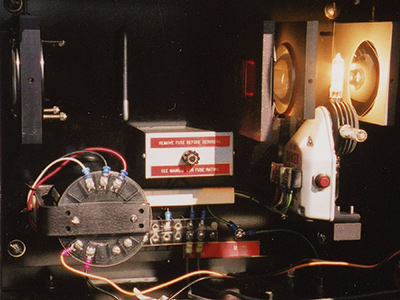
(Bob Trapani, Jr. photo)
How best to show the channel’s centerline was the question considered by the United States Coast Guard at the time. When talking about directional lights in 2010, Jon Grasson, Signal & Power Team Leader at U.S. Coast Guard Headquarters, said, “Our program manager always advocates for a two-station range to define a channel. That said, sector lights are used at locations where it is impossible to install two range towers.”
Grasson went on to say, “The problem with sectors is that it provides no indication of lateral position. You are either in the central ‘white’ sector or you are not. The white sector can be very wide at a distance and knowing where you are in that sector (port or starboard) is not apparent by viewing the light.”
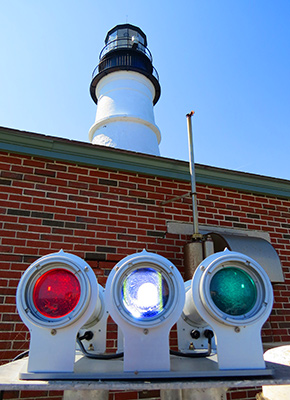
(Bob Trapani, Jr. photo)
However, given the historic location and inherent space limitations at Portland Head, the only suitable option for the Coast Guard was the installation of a small directional light.
According to the U.S. Coast Guard, “Directional lights are a form of ‘single-station’ range lights. The optical components project a horizontal array of encoded light signals, with precise boundaries between one signal and the next.”
The Coast Guard goes on to note, “The usual means of encoding the light signals is by use of different colors, with red and green on either side of a central, white sector (hence the name ‘sector lights’). The mariner maintains a track along the centerline of a channel by remaining within the white sector. If a vessel crosses a sector boundary, the mariner will observe a color change in the light signal.”
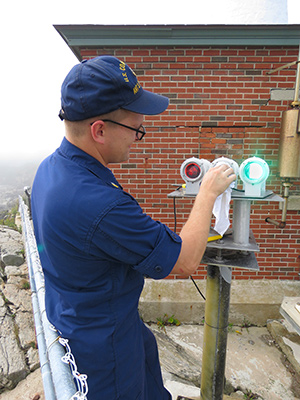
(Bob Trapani, Jr. photo)
A directional light will show the red sector on the side of the channel with the red buoys and the green sector on the side of the channel with the green buoys. If the captain of a ship observes the colors red or green of the aid while traversing the channel, it is suggested that they adjust their course accordingly until the white light is showing centerline once more.
While providing indication of a vessel’s position in regards to the center of the channel, the white sector (good water) typically covers 40 to 50% of the width of the channel at the far end.
The original Align-Light 601 directional light remained in use at Portland Head for forty years (1972 to 2012) before it was replaced by the United States Coast Guard on September 10, 2012.
What took its place was nothing short of cutting edge technology. Whereas the original model required incandescent lamps and replaceable components, the new model – a VLS-46 light emitting diode (LED) sector light, was completely self-contained with no moving parts. The VLS-46 LED Sector Light was originally manufactured by Vega Industries in New Zealand.
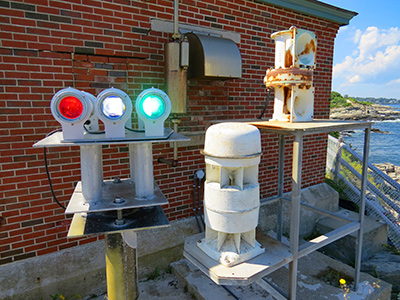
(Bob Trapani, Jr. photo)
The old Align-Light 601 model was very ‘boxy’ in appearance and displayed its red, white and green sectors from one small lens opening. In contrast, the new VLS-46 took on more of a state-of-the-art appearance and utilized three separate projects to display its red, white and green signal – one projector per color. The electronics for the VLS-46 are located at the end of the projectors in an impact-resistant housing.
Sabik, a Carmanah company who took on the line of Vega Industries’ marine products, notes, “The VLS-46 sector light brings a new solution to an old problem. In the past, safe passage was achieved by having two leading lights lined up on top of each other to inform the mariner they were in a safe passage. If the lights were directly aligned above each other, the mariner knew they were on the centerline of their approach. However, adverse marine conditions often pushed the mariner off the centerline to an unknown and hazardous condition.”
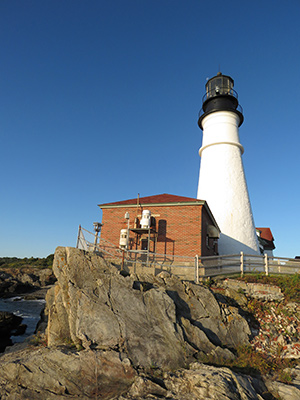
(Bob Trapani, Jr. photo)
In regards to maintenance, the responsible servicing unit – U.S. Coast Guard Aids to Navigation Team South Portland, inspects the VLS-46 sector light during each and every visit to Portland Head Lighthouse. In addition to servicing the sector light, lighthouse technicians also perform preventative maintenance work on the DCB-224 rotating beacon at the top of the tower, the station’s sound signal systems and all of the electronic components associated with the navigational aid equipment.
Since the VLS-46 LED sector light is so highly efficient, there is very little work associated with keeping the unit watching properly. “The unit is self-contained, so all we do is check the power supply and clean the lenses with a mild soapy water detergent,” says Electrician Mate First Class Michael Ditch of USCG Aids to Navigation Team South Portland.
Although Portland Head is the only lighthouse in Maine with a VLS-46 LED sector light to enhance its navigational value to mariners, chances are this valuable aid will continue to maintain a very low profile with the visiting public.
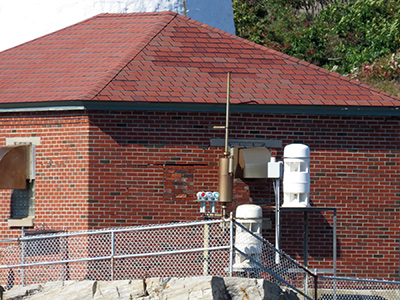
(Bob Trapani, Jr. photo)
The light is situated in plain sight and yet it remains mostly obscure from the perspective of visitor awareness. Its guiding beams are not seen by the landlubber, and its unusual appearance only serves to further confound observers as to its purpose.
However, such public anonymity does not deter the great appreciation that professional mariners have for the VLS-46 LED sector light. Quietly, the aid continues in its mission to safeguard vessels, all the while adding to the lifesaving heritage of Maine’s very first lighthouse – the majestic Portland Head Light!
VLS-46 LED Sector Light Quick Facts
- The unit is lighted 24-hours per day.
- The unit’s narrow beams of light are visible 15 to 19 nautical miles by night and 1.6 to 3 miles by day.
- High intensity LED light source.
- Large vertical divergence for visibility by all types of vessels.
- Energy-efficient LED technology is ideal for solar-powered sites.
- Maintenance free design (no moving parts) saves money and time.
- Lightweight marine-grade aluminum construction makes the unit light and easy to handle.
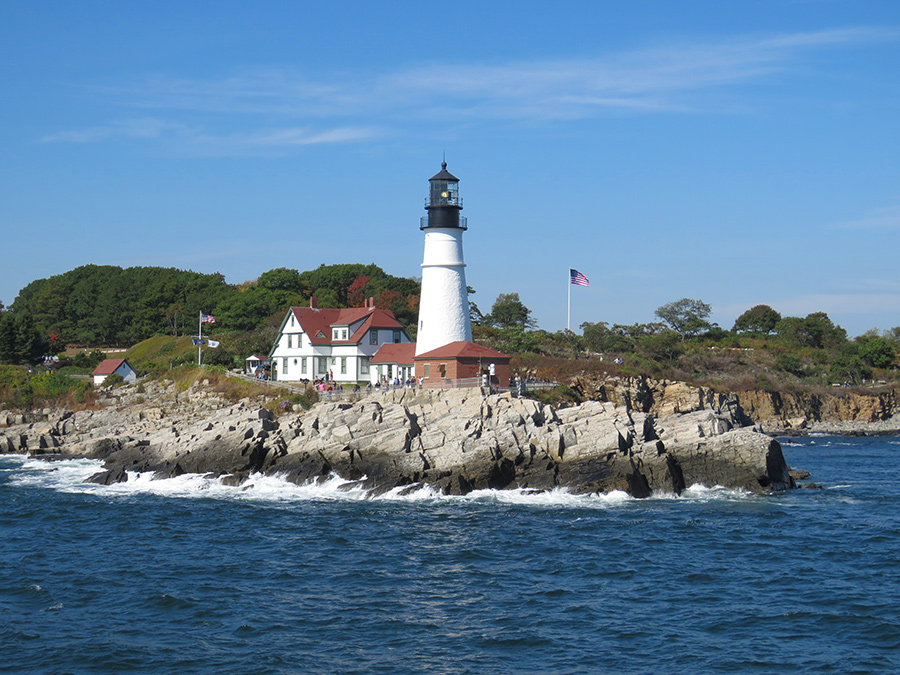
Wonderful article thanks so much for the info .
Great recap of the history! Lots of details